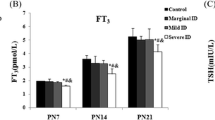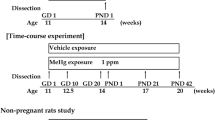Abstract
Iodine is a significant micronutrient. Iodine deficiency (ID)-induced hypothyroxinemia and hypothyroidism during developmental period can cause cerebellar dysfunction. However, mechanisms are still unclear. Therefore, the present research aims to study effects of developmental hypothyroxinemia caused by mild ID and hypothyroidism caused by severe ID or methimazole (MMZ) on parallel fiber–Purkinje cell (PF-PC) synapses in filial cerebellum. Maternal hypothyroxinemia and hypothyroidism models were established in Wistar rats using ID diet and deionized water supplemented with different concentrations of potassium iodide or MMZ water. Birth weight and cerebellum weight were measured. We also examined PF-PC synapses using immunofluorescence, and western blot analysis was conducted to investigate the activity of Neurexin1/cerebellin1 (Cbln1)/glutamate receptor d2 (GluD2) tripartite complex. Our results showed that hypothyroxinemia and hypothyroidism decreased birth weight and cerebellum weight and reduced the PF-PC synapses on postnatal day (PN) 14 and PN21. Accordingly, the mean intensity of vesicular glutamate transporter (VGluT1) and Calbindin immunofluorescence was reduced in mild ID, severe ID, and MMZ groups. Moreover, maternal hypothyroxinemia and hypothyroidism reduced expression of Neurexin1/Cbln1/GluD2 tripartite complex. Our study supports the hypothesis that developmental hypothyroxinemia and hypothyroidism reduce PF-PC synapses, which may be attributed to the downregulation of Neurexin1/Cbln1/GluD2 tripartite complex.







Similar content being viewed by others
References
Puig-Domingo M, Vila L (2013) The implications of iodine and its supplementation during pregnancy in fetal brain development. Curr Clin Pharmaco 8:97–109
Zimmermann MB (2009) Iodine deficiency. Endocr Rev 30:376–408
Berbel P, Obregon MJ, Bernal J, Escobar del Rey F, Morreale de Escobar G (2007) Iodine supplementation during pregnancy: a public health challenge. Trends Endocrinol Metab 18:338–343
Glinoer G (2001) Potential consequences of maternal hypothyroidism on the offspring: evidence and implications. Horm Res 55:109–114
Tang Z, Liu W, Yin H, Wang P, Dong J, Wang Y, Chen J (2007) Investigation of intelligence quotient and psychomotor development in schoolchildren in areas with different degrees of iodine deficiency. Asia Pac J Clin Nutr 16:731–737
Pearce EN, Andersson M, Zimmermann MB (2013) Global iodine nutrition: where do we stand in 2013? Thyroid 23:523–528
Skeaff SA (2011) Iodine deficiency in pregnancy: the effect on neurodevelopment in the child. Nutrients 3:265–273
Lavado-Autric R, Ausó E, García-Velasco JV, et al. (2003) Early maternal hypothyroxinemia alters histogenesis and cerebral cortex cytoarchitecture of the progeny. J Clin Invest 111:1073–1082
Pop VJ, Kuijpens JL, van Baar AL, et al. (1999) Low maternal free thyroxine concentrations during early pregnancy are associated with impaired psychomotor development in infancy. Clin Endocrinol 50:149–155
Morreale de Escobar G, Obregon MJ, Escobar del Rey F (2000) Is neuropsychological development related to maternal hypothyroidism or to maternal hypothyroxinemia? J Clin Endocrinol Metab 85:3975–3987
Morreale de Escobar G, Obregon MJ, Escobar del Rey F (2004) Role of thyroid hormone during early brain development. Eur J Endocrinol 151:U25–U37
Bath SC, Steer CD, Golding J, Emmett P, Rayman MP (2013) Effect of inadequate iodine status in UK pregnant women on cognitive outcomes in their children: results from the Avon Longitudinal Study of Parents and Children (ALSPAC). Lancet 382:331–337
Finken MJ, van Eijsden M, Loomans EM, Vrijkotte TG, Rotteveel J (2013) Maternal hypothyroxinemia in early pregnancy predicts reduced performance in reaction time tests in 5- to 6-year-old offspring. J Clin Endocrinol Metab 98:1417–1426
Brooks VB (1984) Cerebellar functions in motor control. Hum Neurobiol 2:251–260
Hibi M, Shimizu T (2012) Development of the cerebellum and cerebellar neural circuits. Dev Neurobiol 72:282–301
Mishina M, Uemura T, Yasumura M, Yoshida T (2012) Molecular mechanism of parallel fiber-Purkinje cell synapse formation. Front Neural Circuits 6:90
Lee SJ, Uemura T, Yoshida T, Mishina M (2012) GluRδ2 assembles four neurexins into trans-synaptic triad to trigger synapse formation. J Neurosci 32:4688–4701
Kurihara H, Hashimoto K, Kano M, et al. (1997) Impaired parallel fiber–>Purkinje cell synapse stabilization during cerebellar development of mutant mice lacking the glutamate receptor delta2 subunit. J Neurosci 17:9613–9623
Wang W, Nakadate K, Masugi-Tokita M, et al. (2014) Distinct cerebellar engrams in short-term and long-term motor learning. Proc Natl Acad Sci U S A 111:E188–E193
Rochefort C, Lefort JM, Rondi-Reig L (2013) The cerebellum: a new key structure in the navigation system. Front Neural Circuits 7:35
Pregno G, Frola E, Graziano S, et al. (2013) Differential regulation of neurexin at glutamatergic and GABAergic synapses. Front Cell Neurosci 7:35
Craig AM, Kang Y (2007) Neurexin-neuroligin signaling in synapse development. Curr Opin Neurobiol 17:43–52
De Wit J, Sylwestrak E, O'Sullivan ML, et al. (2009) LRRTM2 interacts with Neurexin1 and regulates excitatory synapse formation. Neuron 64:799–806
Kavety B, Morgan JI (1998) Characterization of transcript processing of the gere encoding precerebellin-1. Brain Res Mol Brain Res 63:98–104
Yuzaki M (2011) Cbln1 and its family proteins in synapse formation and maintenance. Curr Opin Neurobiol 21:215–220
Hirai H, Pang Z, Bao D, et al. (2005) Cbln1 is essential for synaptic integrity and plasticity in the cerebellum. Nat Neurosci 8:1534–1541
Matsuda K, Yuzaki M (2011) Cbln family proteins promote synapse formation by regulating distinct neurexin signaling pathways in various brain regions. Eur J Neurosci 33:1447–1461
Yuzaki M (2009) New (but old) molecules regulating synapse integrity and plasticity: Cbln1 and the delta2 glutamate receptor. Neuroscience 162:633–643
Koibuchi N, Chin WW (2000) Thyroid hormone action and brain development. Trends Endocrinol Metab 11:123–128
Koibuchi N (2008) The role of thyroid hormone on cerebellar development. Cerebellum 7:530–533
Wang Y, Wang Y, Dong J, et al. (2014) Developmental hypothyroxinaemia and hypothyroidism limit dendritic growth of cerebellar Purkinje cells in rat offspring: involvement of microtubule-associated protein 2 (MAP2) and stathmin. Neuropathol Appl Neurobiol 40:398–415
Wang Y, Wang Y, Dong J, et al. (2014) Developmental hypothyroxinemia and hypothyroidism reduce proliferation of cerebellar granule neuron precursors in rat offspring by downregulation of the sonic hedgehog signaling pathway. Mol Neurobiol 49:1143–1152
Reeves PG, Nielsen FH, Fahey Jr GC (1993) AIN-93 purified diets for laboratory rodents: final report of the American Institute of Nutrition ad hoc writing committee on the reformulation of the AIN-76A rodent diet. J Nutr 123:1939–1951
Wang Y, Wei W, Wang Y, et al. (2013) Neurotoxicity of developmental hypothyroxinemia and hypothyroidism in rats: impairments of long-term potentiation are mediated by phosphatidylinositol 3-kinase signaling pathway. Toxicol Appl Pharmacol 271:257–265
Wei W, Wang Y, Wang Y, et al. (2013) Developmental hypothyroxinemia induced by maternal mild iodine deficiency delays hippocampal axonal growth in the rat offspring. J Neuroendocrinol 25:852–862
Duong L, Klitten LL, Møller RS, et al. (2012) Mutations in NRXN1 in a family multiply affected with brain disorders: NRXN1 mutations and brain disorders. Am J Med Genet B Neuropsychiatr Genet 159B:354–358
Elibol-Can B, Kilic E, Yuruker S, Jakubowska-Dogru E (2014) Investigation into the effects of prenatal alcohol exposure on postnatal spine development and expression of synaptophysin and PSD95 in rat hippocampus. Int J Dev Neurosci 33:106–114
Kimura-Kuroda J, Nagata I, Negishi-Kato M, Kuroda Y (2002) Thyroid hormone-dependent development of mouse cerebellar Purkinje cells in vitro. Brain Res Dev Brain Res 137:55–65
Rinaldo L, Hansel C (2010) Ataxias and cerebellar dysfunction: involvement of synaptic plasticity deficits? Funct Neurol 25:135–139
Rowen L, Young J, Birditt B, et al. (2002) Analysis of the human neurexin genes: alternative splicing and the generation of protein diversity. Genomics 79:587–597
Tabuchi K, Südhof TC (2002) Structure and evolution of neurexin genes: insight into the mechanism of alternative splicing. Genomics 79:849–859
Matsuda K, Miura E, Miyazaki T, et al. (2010) Cbln1 is a ligand for an orphan glutamate receptor delta2,a bidirectional synapse organizer. Science 328:363–368
Ito-Ishida A, Miura E, Emi K, et al. (2008) Cbln1 regulates rapid formation and maintenance of excitatory synapses in mature cerebellar Purkinje cells in vitro and in vivo. J Neurosci 28:5920–5930
Miura E, Iijima T, Yuzaki M, Watanabe M (2006) Distinct expression of Cbln family Mrna in developing and adult mouse brains. Eur J Neurosci 24:750–760
Hirano T (2012) Glutamate-receptor-like molecule GluRδ2 involved in synapse formation at parallel fiber-Purkinje neuron synapses. Cerebellum 11:71–77
Cao J, Viholainen JI, Dart C, Warwick HK, Leyland ML, Courtney MJ (2005) The PSD95-nNOS interface: a target for inhibition of excitotoxic p38 stress-activated protein kinase activation and cell death. J Cell Biol 168:117–126
Ehrlich I, Malinow R (2004) Postsynaptic density 95 controls AMPA receptor incorporation during long-term potentiation and experience-driven synaptic plasticity. J Neurosci 24:916–927
Garner CC, Nash J, Huganir RL (2000) PDZ domains in synapse assembly and signalling. Trends Cell Biol 10:274–280
Dong J, Wang Y, Wang Y, et al. (2013) Iodine deficiency increases apoptosis and decreases synaptotagmin-1 and PSD-95 in rat hippocampus. Nutr Neurosci 16:135–141
Acknowledgments
This work was supported by Important Platform of Science and Technology for the Universities in Liaoning Province (Grant number 16010) and Program for Liaoning Innovative Research Team in University (Grant number LT2015028).
Author’s Contributions
Jie Chen and Weiping Teng conceived and designed the study Yuan Wang, Jing Dong, Yi Wang, Wei Wei, Binbin Song performed the experiments. Weiping Teng and Jie Chen obtained funding and ethics approval. Yuan Wang, Jing Dong, Yi Wang, Zhongyan Shan and Jie Chen analyzed the data. Yuan Wang wrote the article in whole. Jing Dong, Yi Wang and Jie Chen revised the article.
Author information
Authors and Affiliations
Corresponding author
Ethics declarations
Conflict of Interest
The authors declare that they have no conflict of interest.
Rights and permissions
About this article
Cite this article
Wang, Y., Dong, J., Wang, Y. et al. Developmental Hypothyroxinemia and Hypothyroidism Reduce Parallel Fiber–Purkinje Cell Synapses in Rat Offspring by Downregulation of Neurexin1/Cbln1/GluD2 Tripartite Complex. Biol Trace Elem Res 173, 465–474 (2016). https://doi.org/10.1007/s12011-016-0664-9
Received:
Accepted:
Published:
Issue Date:
DOI: https://doi.org/10.1007/s12011-016-0664-9




